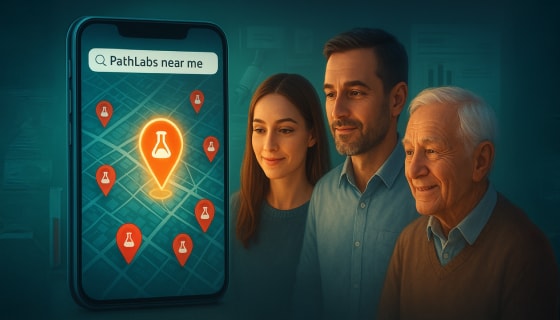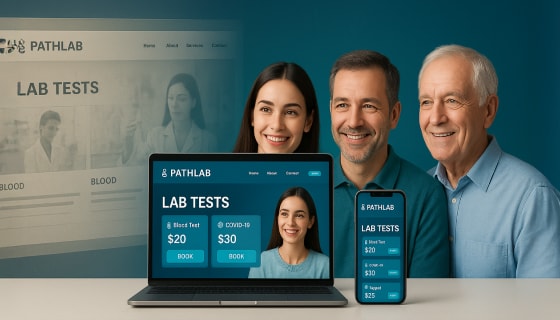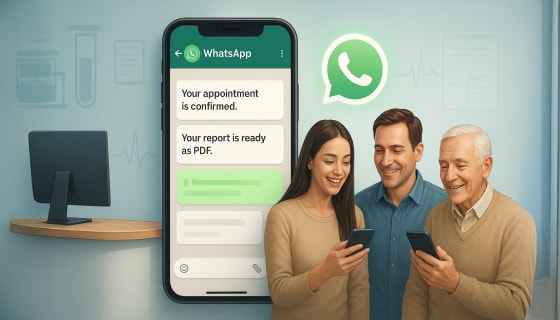Still not leveraging video in your healthcare marketing? Well, that’s like trying to perform surgery with a butter knife—technically possible, but unnecessarily risky? Here’s the deal: video isn’t just a “nice-to-have” anymore, it’s the secret sauce that’s turning browsers into patients.
Quick facts to make you sit up:
- 84% of people admit they’ve bought something because of a brand’s video (even healthcare stuff!)
- Over 70% of social media users can’t get enough of videos every single day.
People want stories they can see and feel, not just jargon they have to Google twice. So if you’re still thinking “We don’t need video,” it’s time for a reality check. Healthcare video marketing isn’t just flashy—it’s a powerful way to build trust, explain complicated stuff, and get patients through your doors (or on your calendar).
Ready to stop playing catch-up? Let’s dive into why video is now the game-changer for healthcare brands.
The Impact of Videos on Healthcare Brands
Let’s cut to the chase: if you think a fancy flyer or a wall of text will win patient trust in 2025, you’re dreaming. 41% of people reported that social media influences their choice of hospital, medical practice, or doctor.
Harnessing the power of video content in healthcare is not just a trend—it’s a proven strategy that transforms patient engagement and communication. Patients want to see, hear, and feel your care before walking in. So, if your brand isn’t leveraging video yet, you’re asking patients to trust a faceless email.
Why video content is more potent than other formats
Emails get deleted, blogs get skimmed, and static posts get ignored—unless you’re a cat video (and even then, no promises). But video? Video demands attention. It combines visuals, voice, and storytelling in one neat package that sticks. Especially in healthcare, where jargon runs rampant and patience is thin, healthcare video marketing is your best chance to make things crystal clear without sounding like you’re reading from a textbook.
How it helps build credibility and connect with patients
Healthcare is deeply personal and can often feel overwhelming. A doctor’s explanation or a patient’s firsthand story can provide clarity, reassurance, and trust. Video marketing healthcare lets you show empathy, transparency, and expertise simultaneously. It’s like having a friendly, knowledgeable guide with your patients, turning strangers into believers and casual visitors into loyal patients.
Video Isn’t Just Content—It’s How Patients Connect and Engage
If you still think healthcare communication is all about brochures or static websites, it’s time to rethink. On social media, patients expect more—they want transparent, authentic, and engaging video content that speaks directly to their concerns. Whether it’s a quick explainer about a procedure, a heartfelt patient testimonial, or a doctor sharing treatment options, video content on platforms like Instagram, Facebook, and YouTube lets you meet patients where they are—ready to trust, understand, and engage. Ignoring video means missing the chance to build a deeper connection and risking becoming another faceless brand in the crowded healthcare space.

Why Skipping Video Content Marketing Is Risky for Healthcare Providers
Overlooking video in your healthcare social media strategy—whether promoting services, clinics, or your medical brand on platforms like Facebook, Instagram, YouTube, or LinkedIn—means missing a critical tool for effective patient engagement and brand visibility. You might get a few steps in, but won’t win the race. Patients today expect more than words; they want connection, clarity, and trust, all of which video content delivers far better. Falling behind on video marketing means missing out on the powerful opportunity to engage your audience across these key social platforms. It risks losing ground to competitors who use video to educate, build trust, and grow their patient base.
Patient Expectations Are Evolving—Fast
Healthcare seekers aren’t browsing brochures anymore. They’re watching videos, scrolling through stories, and seeking answers on social platforms. Your patients want quick, relatable, and trustworthy content. With video content in healthcare offering immediate understanding and emotional resonance, the bar has been raised. If your brand isn’t meeting these expectations, you risk losing relevance—and patients—to those who do.
Your Competitors Are Already Playing the Video Game
As you consider incorporating video into your strategy, competitors already capture patient attention through authentic and engaging content. From sharing behind-the-scenes clips to offering virtual consultations and patient testimonials, they’re harnessing strategies for healthcare social media marketing that position them as accessible and trustworthy. Falling behind means giving your audience a reason to choose someone else who’s already speaking their language.
The Cost of Falling Behind
Skipping video isn’t just missing a marketing trend and patient engagement, loyalty, and growth opportunities. The healthcare market is fiercely competitive, and every moment without video content means losing ground in social media healthcare marketing. Patients gravitate toward brands that educate, empathize, and engage—videos do that like nothing else. The longer you wait, the steeper the climb back to relevance.
How Healthcare Social Media Marketing Differs from Traditional Strategies
When marketing healthcare services on social media, the usual strategies don’t apply. Here are the key distinctions to consider when planning your approach:
Strict Regulatory Requirements
Healthcare marketing must navigate rigorous rules imposed by bodies like HIPAA and the FDA in the U.S., which protect patient privacy and sensitive data. This means every post and interaction needs to be carefully managed to avoid violations. Agencies specializing in healthcare marketing have the expertise to operate safely within these regulations while effectively targeting specific medical sectors.
Demand for Accurate Medical Content
Unlike general social media marketing, healthcare requires precise and reliable information. Sharing inaccurate health details can lead to serious legal repercussions and jeopardize patient well-being. Additionally, healthcare marketers face the ongoing challenge of addressing misinformation and debunking health-related myths on social platforms.
Preparedness for Crisis Communication
Healthcare organizations must be ready to respond promptly and transparently during crises, whether a public health emergency, medical incident, or other urgent matter. Managing communications effectively in these situations is vital to upholding trust and credibility with the audience.
Industry-Specific Success Metrics
Instead of focusing solely on engagement metrics like likes and shares, healthcare marketing places higher value on patient satisfaction and Net Promoter Scores (NPS) indicators. Building credibility and trust often outweighs pure popularity when managing a healthcare brand’s reputation.
Emerging Video Marketing Trends in Healthcare for 2025
Think video marketing in healthcare is just talking heads and dull animations? Think again. The landscape is shifting faster than you can hit “upload,” and if you don’t adapt, you’ll be left behind with outdated tactics. In this section, we dive into the newest, most innovative video trends shaping healthcare social media marketing in 2025—trends that look good and drive results.
You’ll discover how to leverage new formats, platforms, and strategies that capture attention, build trust, and get patients clicking “book appointment” instead of scrolling past. Ready to future-proof your healthcare brand and use video as your social media powerhouse? Let’s dive into the trends that will keep your brand relevant and top-of-mind this year.
What’s Trending Now in Healthcare Video Content—and Why It Matters
Voice-Activated Interactive Videos: Enabling patients to navigate video content or ask questions via voice commands, creating hands-free, accessible learning experiences.
Live Streaming: Real-time sessions for Q&As, virtual clinic tours, and patient interactions that boost transparency and trust instantly.
Shoppable Video for Healthcare Products: Integrating clickable product links into videos allows patients to seamlessly order supplements, devices, or wellness kits.
Educational Series & Webinars: Deep dives into complex topics presented in an easy-to-understand format, building authority and patient confidence.
Behind-the-Scenes Content: Authentic glimpses into healthcare teams and facilities, humanizing your brand, and breaking down barriers.
Micro-Moments Content: Ultra-short, context-aware videos designed for ‘in-the-moment’ patient needs—think immediate tips or reminders delivered at precisely the right time.
AI-Driven Video Analytics for Patient Insights: Using video engagement data combined with AI to optimize content and predict patient interests or concerns for targeted follow-ups.
Sustainability & Social Impact Storytelling: Videos highlighting your healthcare brand’s eco-friendly practices or community initiatives, building deeper emotional bonds with conscious consumers.
The Role of Video Trends in Shaping Patient Engagement and Marketing Strategies
Video trends aren’t just fads—they’re powerful forces reshaping how healthcare brands connect with patients and approach marketing. As these trends evolve, they redefine patient expectations and open new doors for engagement. Today’s patients want more than static information; they crave authentic, personalized, and interactive experiences that videos deliver better than any other medium.
By embracing emerging video formats—whether AI-driven personalization, immersive augmented reality, or bite-sized micro-moments—healthcare marketers can craft strategies that speak directly to individual patient needs. This shift moves marketing away from broad, generic messaging to targeted, meaningful conversations that build trust and inspire action.
The result? Patients feel seen and understood, increasing their willingness to engage, follow care recommendations, and choose your brand over competitors. Meanwhile, marketing strategies become more innovative and efficient, leveraging real-time analytics from video interactions to continuously optimize content and outreach.
Choosing the Right Video Content Formats
The correct video format is essential for communicating complex healthcare information effectively and building patient trust. Tailoring your videos to fit specific platforms and patient needs ensures your healthcare messages resonate and drive meaningful engagement.
Explainer videos: These are usually 1–3 minutes long and perfect for explaining complex medical information clearly. They help patients understand treatments and build confidence.
Patient testimonials: Generally under 2 minutes, great for sharing real patient stories. These build emotional connections and increase trust in your care.
Live streams and webinars: Lasting 10–60 minutes, are ideal for real-time education and interaction. They foster transparency and deepen patient relationships.
Animated videos: These last 1–2 minutes simplify medical concepts visually. They make complex information accessible and ease patient anxiety.
Behind-the-scenes videos: These are typically 1–3 minutes long and offer an authentic look at your team and facility. They humanize your brand and make patients feel comfortable.
Surgical or procedure walkthroughs: 3–10 minutes, suitable for detailed treatment explanations. They set realistic expectations and reduce fears.
FAQ videos are usually 1–3 minutes long and answer common patient questions. They save time and improve patient satisfaction.
Promotional videos: These last 30 seconds to 1 minute and are designed to highlight services or special offers. They drive awareness and encourage action.
Patient education series: Multiple videos of 3–10 minutes each, ideal for ongoing health guidance. They help build trust and improve patient outcomes.
The Impact of Video Content on Google Rankings
Video content is more than just engaging storytelling—it’s a powerful driver of SEO performance that healthcare brands can’t afford to ignore. Google prioritizes websites with videos because they increase visitors’ time on your pages, signaling quality and relevance. This boosts your site’s authority and improves your position in search results, making it easier for potential patients to find you.
Additionally, videos often appear as rich snippets or in video carousels on Google’s search pages, increasing your brand’s visibility and click-through rates. For healthcare providers, video is a tool for education, trust-building, and a critical asset for organic traffic growth and patient discovery.
Key SEO Benefits of Video Content in Healthcare:
- Improves Dwell Time: Videos keep visitors engaged longer, signaling valuable content to Google.
- Increases Click-Through Rates: Video thumbnails in search results attract more clicks than text-only listings.
- Enhances User Experience: Videos simplify complex healthcare topics, reducing bounce rates.
- Boosts Backlinks and Shares: Engaging video content encourages more external links and social shares, strengthening SEO.
- Supports Voice Search: Video transcripts improve keyword presence for voice-activated queries.
- Enables Rich Snippets: Videos help your listings stand out with rich media in Google’s search results.
By strategically integrating video into your healthcare website and marketing efforts, you will educate and engage your audience and climb higher in Google rankings, leading to more organic patient visits and stronger brand authority.
Examples from Top Healthcare Brands Using Video Well
VisualFizz created a social media explainer video for a healthcare brand. The video simplified complex medical information to make consumers more comfortable with the product and process. This strategy not only enhanced brand trust but also boosted patient engagement.
Similarly, RegenPro, a healthcare provider specializing in regenerative medicine, used video marketing to achieve a 300% increase in sales. By leveraging patient testimonial videos on platforms like YouTube Shorts and Instagram Reels, along with targeted advertising, the clinic experienced a remarkable rise in bookings and revenue.
In a different yet equally effective approach, Queensland Health in Australia tackled a taboo subject with humor by creating an Instagram video campaign encouraging people to feel comfortable defecating at work. The campaign’s innovative and engaging nature garnered over 22,000 likes on Instagram, showcasing the power of video to engage and spark conversation across social media platforms.
Best Practices for Creating Effective Healthcare Video Content
Effective healthcare video content requires a thoughtful blend of clear messaging, tone, and technical precision. Videos must communicate complex medical information in a way that’s easy to understand while building trust and empathy with patients.
Ensuring accessibility and compliance is critical to reaching diverse audiences and upholding healthcare standards. Finally, good video quality and strong call-to-action maximize engagement and drive patients to take meaningful next steps. Here are some essential best practices to keep in mind:
- Use the Features-Advantages-Benefits (FAB) framework: Clearly explain what your service offers, why it matters, and how it benefits patients.
- Align video tone with trusted healthcare personas: Be calm, authoritative, and empathetic to foster patient confidence.
- Ensure accessibility and compliance: Include captions and audio descriptions, and follow HIPAA and other healthcare regulations.
- Be sensitive and inclusive: Use language and visuals that respect diverse patient backgrounds and conditions.
- Maintain high video and audio quality: Clear visuals and sound keep viewers engaged and convey professionalism.
- Keep videos concise: Aim for 1 to 3 minutes to hold attention while delivering key information.
- Include strong calls-to-action (CTAs): Guide patients on what to do next, like booking an appointment or exploring more resources.
Conclusion
Video content has become a powerful tool in healthcare social media marketing, allowing providers to connect with patients more deeply. From patient testimonials to procedure explainers, video content builds trust, engages patients, and educates them in ways that traditional methods can’t. If you’re looking for an experienced partner to enhance your healthcare marketing efforts—from creating impactful video content to improving patient engagement—ZealousWeb is here to assist. Connect with our expert team to explore tailored healthcare social media marketing strategies, designed to create a more personalized, efficient, and patient-centric experience for your brand.














